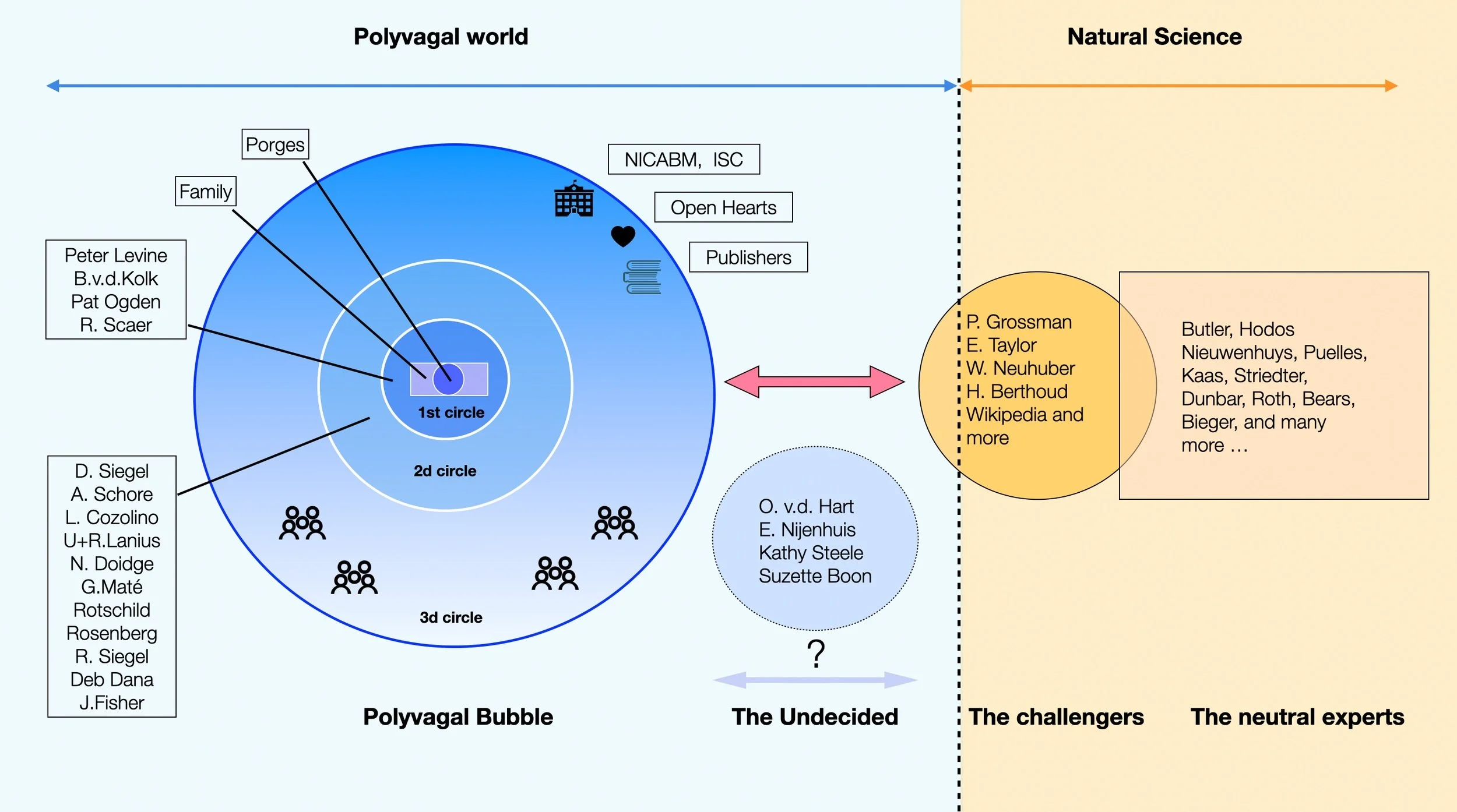1.9.0
Polyvagal Community: An Overview
Polyvagal World vs. the Scientific Community. This is our interpretation and can be challenged anytime (©absb, 2024).
This diagram illustrates how the Polyvagal Theory (PVT) has spread within a self-sustaining network despite scientific challenges. It represents three bubbles within two distinct intellectual domains: the Polyvagal World (on the left, in light blue) and Natural Science (on the right, in yellow).
The Polyvagal Community
The Polyvagal Community consists of three concentric circles of influence surrounding a central nucleus. This bubble shows how ideas, even those with questionable scientific validity, can gain traction and self-perpetuate through a network of interconnected supporters.
The Nucleus: At the core is Stephen W. Porges, the founder of Polyvagal Theory, surrounded by his family (his wife, Sue Carter, and his sons, Eric and Seth), emphasizing the personal and professional interconnections sustaining the theory.
The First Circle (Inner Circle of Early Allies): This includes figures who were early adopters and promoters of PVT before 2000. Peter Levine, Bessel van der Kolk, Pat Ogden, and Robert Scaer played a crucial role in integrating Polyvagal Theory into trauma therapy, somatic healing, and psychology.
The Second Circle (Established Advocates and Promoters): A group of well-known authors and clinicians who have incorporated Polyvagal Theory into their work and writings. This includes figures such as Daniel Siegel, Allan Schore, Louis Cozolino, U. & R. Lanius, Norman Doidge, Gabor Maté, Babette Rothschild, Stanley Rosenberg, Ronald Siegel, Deb Dana, and Janina Fisher.
The Third Circle (Broader Network of Influence): This circle extends to therapists, lay supporters, publishing houses, and organizations propagating PVT through books, workshops, and online content. This includes institutions like NICABM (National Institute for the Clinical Application of Behavioral Medicine), ISC (International Society for the Study of Trauma and Dissociation), Open Hearts, and various publishers. Their involvement facilitates the commercial and widespread dissemination of the theory.
The Casual Visitors
Between the Polyvagal Community and the Natural Science field, an intermediate group of “casual visitors” exists. This includes authors referencing or discussing PVT without fully committing to its claims, such as Onno van der Hart, Ellert Nijenhuis, Kathy Steele, and Suzette Boon. Their stance is ambiguous, as they neither firmly reject nor rigorously support PVT.
The Scientific Community
This section represents the scientific community that evaluates PVT based on rigorous evidence. It is divided into two subgroups:
The Challengers (Scientific Critics of PVT): Scientists such as Paul Grossman, E. Taylor, W. Neuhuber, and H. Berthoud actively critique Polyvagal Theory, questioning its scientific validity and mechanistic explanations.
The Neutral Experts (Independent Neuroscientists & Anatomists): A broad category of respected neuroanatomists and neuroscientists who do not engage with PVT and remain focused on mainstream research. This includes Butler, Hodos, Nieuwenhuys, Puelles, Kaas, Striedter, Dunbar, Roth, Bears, Bieger, and others.
In conclusion, this diagram visually represents how scientifically weak theories can create self-reinforcing intellectual bubbles, where ideas gain traction not necessarily due to their scientific validity but through networks of personal relationships, professional alliances, and institutional support. Despite scientific pushback from the challengers, the Polyvagal Bubble sustains itself by continuously influencing new generations of therapists, writers, and organizations.
>> next chapter Vocabulary of Neuroanatomy
